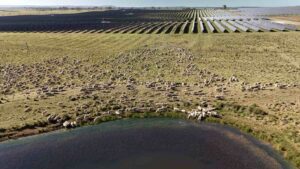One of the big laments of the current government, regulators and many consumers is the lack of clarity around the workings of the energy market. Confusion is profit and has been profitable, as any quick analysis of the retail offerings reveal.
But the lack of visibility around the workings of the market appear to be getting worse. Earlier this month, Snowy Hydro announced in a blaze of publicity that they had signed up 880MW of new wind and solar projects at a “game changing” price of less than $70/MWh, inluding the price of “firming,” or as the government would say “making it fair dinkum”.
This sounded like fantastic news. Snowy Hydro told us the contracts were for four wind and four solar projects, but then told us no more. Neither the identity of the companies that won the contracts, or the projects themselves were revealed. “That’s not for us to say,” the company said.
So far, a few of the winners have come out to fully identify themselves:
These include Spanish group FRV with its 68MW Goonumbla solar project in NSW, Clenergy with its 115MW Metz solar project also in NSW, and LightsourceBP, with a “portfolio of project” it has yet to identify.
Asking around, we also learned that Total Eren has won for an unidentified solar project, Tilt Renewables for half the output of its 336MW Dundonnell wind farm, Macquarie/RES for stage 2 of the Murra Warra wind farm in Victoria, and CWP Renewables, again with project or projects that have not been revealed.
The identity of the remaining wind project or developer still eludes us.
This is quite extraordinary. Sadly, it has become a common practice for contract prices to be hidden from view, even when the tenderer is a government entity. But in the case of Snowy, it is the first time that a tenderer has refused to reveal even the names of the winning developers and their projects.
(The last time that a wind or solar contract was fully disclosed was by the ACT government, which revealed the details of all of its tenders for wind and solar that will deliver the equivalent of 100 per cent of its electricity needs by the end of the year.
(Some private companies have boasted of “record low” deals, such as Origin Energy’s contract with the Stockyard Hill wind farm in Victoria, but again the details are vague. In this case it was the low $50s/MWh.)
Snowy Hydro is no stranger to the practice of burying key details. Earlier this year, it came out with a series of preliminary reports underlying the case for the Snowy 2.0 pumped hydro scheme, a $6 billion project championed by former prime minister Malcolm Turnbull that carries significant uncertainties on its environmental impacts, engineering and economic rationale.
The feasibility study released just before Christmas last year noted a blow out in costs, but crucial chapters on the scheme’s economics, detailed costs and business case were not released.
Some analysts have had a close look at the proposals. Paul Hyslop, in this detailed analysis, wonders how Snowy can deliver any returns on its investment, even if its “heroic” analysis of overall market benefits comes true. And it notes the threat between modular technologies such as battery storage.
One big issue for Snowy 2.0 is the cost of transmission to connect the massive project to places where it might be useful. The cost is put at $2 billion, but could be more.
Snowy CEO Paul Broad has argued that its government owner should provide it with some form of indemnity in case the transmission spending does not pass the pub test, or in the energy circles what is known as RIT-T (Regulated investment test-transmission).
It has even argued that the project should not be bound by the same regulatory reviews that is required for all other projects, because of the potential delays of such a process.
This recent exchange in a Senate Estimates committee is revealing:
Senator KENEALLY: Are there any challenges around an indemnity that the government needs to provide to the board regarding transmission approval before investment?
Broad: With progress since our last meeting, the ISP has been put out by email and that’s been very encouraging for us. It takes a long view and looks at how you would connect to the various renewable zones that are emerging in the marketplace-how the transition works. We’re very encouraged by that. As directors, of course, we need some level of comfort that the transmission would work, only because of the timing issues, to get through the regulatory processes; that’s what we’ve asked for. That’s an important part of the journey. All those discussions are occurring in a very cooperative and constructive way.
Senator KENEALLY: Do you have any time line as to when that might occur?
Mr Broad: We’d like to have that at the time of FID, so in early December.
Early December, of course, is when the board wishes to sign off on the project. The reason for the haste, analysts such as Hyslop suggest, is that Snowy does not want to take no for an answer.
Its great haste is motivated by a fear for its future, and its vulnerability to markets, given that it generates very little of its own power to meet the needs of the one million plus retail and corporate customers.
And it is worried that it is running on a thin time-line for Snowy 2.0, that it is now or never. Any delays will invite competition from rival projects and new technologies such as Tasmania’s Battery of the nation (at half the price), and battery storage – either at the scale of the Tesla big battery in South Australia, or scattered through the grid, and other pumped hydro.
Other technologies include demand management and energy efficiency. It is perhaps no coincidence that Snowy CEO Paul Broad has sought to demonise the demand management scheme proposed by the likes of AEMO to help address peak demand as “blackouts”.
The case for pumped hydro is also a little like that of hydrogen storage. Both will likely be needed in a grid that is dominated by renewables and heading for wind and solar shares of 80, 90 and 100 per cent. But until the grid is dominated by renewables, both are likely to result in even more coal generation.
The estimates provided by an independent report for Snowy and the AEMO analysis in its Integrated System Plan make that clear – Snowy 2.0 means less batteries and more coal generation, at least over the short term.
Snowy has insisted that this is not the plan, and made the tender for wind and solar to try and prove it. Shame about the details, or the lack of them.
Snowy Hydro has now lost its greatest champion, Malcolm Turnbull, although the former PM is still supportive from the outside, tweeting just yesterday that the time for pumped hydro has arrived. But that’s also because Turnbull is now cheering high levels of wind and solar, rather than demonising as he felt he had to do as head of the Coalition.
New energy minister Angus Taylor is also a fan, not least because his grandfather helped design and was commissioner of the original Snowy Hydro scheme. But Taylor is not a fan of wind or solar, arguing that there is already too much in the grid.
This poses an interesting question for the government, who now own Snowy Hydro outright: Does support for Snowy acknowledge the future of renewables, and how does that argument go down in a government so divided it hasn’t a clue what to say about energy, apart from a rhetorical wish for “fair dinkum power”.
We should find out soon. Snowy Hydro wants to make its final investment decision early next month.
Note: We later discovered the eighth project winner, the Woolsthorpe wind farm in Victoria.










